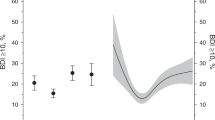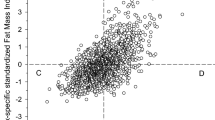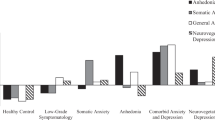Abstract
The aim of the present study was to evaluate the interaction between depressive symptoms and metabolic dysregulations as risk factors for type 2 diabetes. The sample comprised of 2525 adults who participated in a baseline and a follow-up assessment over a 4.5-year period in the Emotional Health and Wellbeing Study (EMHS) in Quebec, Canada. A two-way stratified sampling design was used, on the basis of the presence of depressive symptoms and metabolic dysregulation (obesity, elevated blood sugar, high blood pressure, high levels of triglycerides and decreased high-density lipoprotein). A total of 87 (3.5%) individuals developed diabetes. Participants with both depressive symptoms and metabolic dysregulation had the highest risk of diabetes (adjusted odds ratio=6.61, 95% confidence interval (CI): 4.86–9.01), compared with those without depressive symptoms and metabolic dysregulation (reference group). The risk of diabetes in individuals with depressive symptoms and without metabolic dysregulation did not differ from the reference group (adjusted odds ratio=1.28, 95% CI: 0.81–2.03), whereas the adjusted odds ratio for those with metabolic dysregulation and without depressive symptoms was 4.40 (95% CI: 3.42–5.67). The Synergy Index (SI=1.52; 95% CI: 1.07–2.17) suggested that the combined effect of depressive symptoms and metabolic dysregulation was greater than the sum of individual effects. An interaction between depression and metabolic dysregulation was also suggested by a structural equation model. Our study highlights the interaction between depressive symptoms and metabolic dysregulation as a risk factor for type 2 diabetes. Early identification, monitoring and a comprehensive management approach of both conditions might be an important diabetes prevention strategy.
This is a preview of subscription content, access via your institution
Access options
Subscribe to this journal
Receive 12 print issues and online access
$259.00 per year
only $21.58 per issue
Buy this article
- Purchase on Springer Link
- Instant access to full article PDF
Prices may be subject to local taxes which are calculated during checkout


Similar content being viewed by others
References
Collaborators GBoDS. Global, regional, and national incidence, prevalence, and years lived with disability for 301 acute and chronic diseases and injuries in 188 countries, 1990-2013: a systematic analysis for the Global Burden of Disease Study 2013. Lancet 2015; 386: 743–800.
Ducat L, Philipson LH, Anderson BJ . The Mental Health Comorbidities of Diabetes. JAMA 2014; 312: 691–692.
Knol MJ, Twisk JWR, Beekman ATF, Heine RJ, Snoek FJ, Pouwer F . Depression as a risk factor for the onset of type 2 diabetes mellitus. A meta-analysis. Diabetologia 2006; 49: 837–845.
Mezuk B, Eaton WW, Albrecht S, Golden SH . Depression and type 2 diabetes over the lifespan a meta-analysis. Diabetes Care 2008; 31: 2383–2390.
Rotella F, Mannucci E . Depression as a risk factor for diabetes: a meta-analysis of longitudinal studies. J Clin Psychiatry 2013; 74: 32–38.
Renn BN, Feliciano L, Segal DL . The bidirectional relationship of depression and diabetes: A systematic review. Clin Psychol Rev 2011; 31: 1239–1246.
Schulze MB, Hoffmann K, Boeing H, Linseisen J, Rohrmann S, Mohlig M et al. An accurate risk score based on anthropometric, dietary, and lifestyle factors to predict the development of type 2 diabetes. Diabetes Care 2007; 30: 510–515.
Lindstrom J, Tuomilehto J . The diabetes risk score - A practical tool to predict type 2 diabetes risk. Diabetes Care 2003; 26: 725–731.
Rahman M, Simmons RK, Harding AH, Wareham NJ, Griffin SJ . A simple risk score identifies individuals at high risk of developing Type 2 diabetes: a prospective cohort study. Fam Pract 2008; 25: 191–196.
Joseph J, Svartberg J, Njolstad I, Schirmer H . Incidence of and risk factors for type-2 diabetes in a general population: The Tromso Study. Scand J Public Health 2010; 38: 768–775.
Shin JA, Lee JH, Lim SY, Ha HS, Kwon HS, Park YM et al. Metabolic syndrome as a predictor of type2 diabetes, and its clinical interpretations and usefulness. J Diabetes Investig 2013; 4: 334–343.
McIntyre RS, Rasgon NL, Kemp DE, Nguyen HT, Law CWY, Taylor VH et al. Metabolic syndrome and major depressive disorder: Co-occurrence and pathophysiologic overlap. Curr Diabetes Rep 2009; 9: 51–59.
Vancampfort D, Correll CU, Wampers M, Sienaert P, Mitchell AJ, De Herdt A et al. Metabolic syndrome and metabolic abnormalities in patients with major depressive disorder: a meta-analysis of prevalences and moderating variables. Psychol Med 2014; 44: 2017–2028.
Vogelzangs N, Beekman AT, Boelhouwer IG, Bandinelli S, Milaneschi Y, Ferrucci L et al. Metabolic depression: a chronic depressive subtype? Findings from the InCHIANTI study of older persons. J Clin Psychiatry 2011; 72: 598–604.
Liu CS, Carvalho AF, McIntyre RS . Towards a ‘metabolic’ subtype of major depressive disorder: shared pathophysiological mechanisms may contribute to cognitive dysfunction. CNS Neurol Disord Drug Targets 2014; 13: 1693–1707.
DiMatteo MR, Lepper HS, Croghan TW . Depression is a risk factor for noncompliance with medical treatment - Meta-analysis of the effects of anxiety and depression on patient adherence. Arch Inter Med 2000; 160: 2101–2107.
Awadalla P, Boileau C, Payette Y, Idaghdour Y, Goulet JP, Knoppers B et al. Cohort profile of the CARTaGENE study: Quebec's population-based biobank for public health and personalized genomics. Int J Epidemiol 2013; 42: 1285–1299.
Lamers F, Jonkers CCM, Bosma H, Penninx B, Knottnerus JA, van Eijk JTM . Summed score of the Patient Health Questionnaire-9 was a reliable and valid method for depression screening in chronically ill elderly patients. J Clin Epidemiol 2008; 61: 679–687.
Alberti KG, Eckel RH, Grundy SM, Zimmet PZ, Cleeman JI, Donato KA et al. Harmonizing the metabolic syndrome a joint interim statement of the International Diabetes Federation Task Force on Epidemiology and Prevention; National Heart, Lung, and Blood Institute; American Heart Association; World Heart Federation; International Atherosclerosis Society; and International Association for the Study of Obesity. Circulation 2009; 120: 1640–1645.
Kessler RC, Ustun TB . The World Mental Health (WMH) Survey Initiative Version of the World Health Organization (WHO) Composite International Diagnostic Interview (CIDI). Int J Methods Psychiatr Res 2004; 13: 93–121.
American Psychiatric Association APATFoDSMIV Diagnostic and Statistical Manual of Mental Disorders: DSM-IV-TR. American Psychiatric Association: Washington, DC, 2000.
Craig CL, Marshall AL, Sjostrom M, Bauman AE, Booth ML, Ainsworth BE et al. International physical activity questionnaire: 12-country reliability and validity. Med Sci Sports Exerc 2003; 35: 1381–1395.
Guidelines for data processing and analysis of the International Physical Activity Questionnaire (IPAQ)–short and long forms. https://sites.google.com/site/theipaq/scoring-protocol2005, Accessed Date.
Eyre H, Kahn R, Robertson RM, Writing AAAC . American Cancer Society, the American Diabetes Association, and the American Heart Association.Collaborative Writing Committee.. Preventing cancer, cardiovascular disease, and diabetes - A common agenda for the American Cancer Society, the American Diabetes Association, and the American Heart Association. Diabetes Care 2004; 27: 1812–1824.
Andersson T, Alfredsson L, Kallberg H, Zdravkovic S, Ahlbom A . Calculating measures of biological interaction. Eur J Epidemiol 2005; 20: 575–579.
Bollen KA . Structural Equations with Latent Variables. Wiley: New York, NY, 1989.
Byrne B . Structural Equation Modeling with Mplus: Basic Concepts, Applications, and Programming. Routledge Academic Publishers: New York, 2012.
Muthén LK, Muthén BO . Mplus User’s Guide. Seventh Edition Muthén & Muthén: Los Angeles, CA, 2012.
Knol MJ, VanderWeele TJ . Recommendations for presenting analyses of effect modification and interaction. Int J Epidemiol 2012; 41: 514–520.
Qin L, Knol MJ, Corpeleijn E, Stolk RP . Does physical activity modify the risk of obesity for type 2 diabetes: a review of epidemiological data. Eur J Epidemiol 2010; 25: 5–12.
Tisnado DM, Adams JL, Liu HH, Damberg CL, Chen WP, Hu FA et al. What is the concordance between the medical record and patient self-report as data sources for ambulatory care? Medical Care 2006; 44: 132–140.
Skinner KM, Miller DR, Lincoln E, Lee A, Kazis LE . Concordance between respondent self-reports and medical records for chronic conditions: experience from the Veterans Health Study. J Ambul Care Manage 2005; 28: 102–110.
Margolis KL, Qi LH, Brzyski R, Bonds DE, Howard BV, Kempoinen S et al. Validity of diabetes self-reports in the Women's Health Initiative: comparison with medication inventories and fasting glucose measurements. Clinical Trials 2008; 5: 240–247.
Grenard JL, Munjas BA, Adams JL, Suttorp M, Maglione M, McGlynn EA et al. Depression and medication adherence in the treatment of chronic diseases in the United States: a meta-analysis. J Gen Intern Med 2011; 26: 1175–1182.
Schmitz N, Gariepy G, Smith KJ, Clyde M, Malla A, Boyer R et al. Recurrent subthreshold depression in type 2 diabetes: an important risk factor for poor health outcomes. Diabetes Care 2014; 37: 970–978.
Marazziti D, Rutigliano G, Baroni S, Landi P, Dell'Osso L . Metabolic syndrome and major depression. CNS Spectr 2014; 19: 293–304.
Musselman DL, Evans DL, Nemeroff CB . The relationship of depression to cardiovascular disease - Epidemiology, biology, and treatment. Arch Gen Psychiatry 1998; 55: 580–592.
Pan A, Sun Q, Okereke OI, Rexrode KM, Rubin RR, Lucas M et al. Use of antidepressant medication and risk of type 2 diabetes: results from three cohorts of US adults. Diabetologia 2012; 55: 63–72.
Eckel RH, Alberti K, Grundy SM, Zimmet PZ . The metabolic syndrome. Lancet 2010; 375: 181–183.
Vogelzangs N, Beekman ATF, Dortland A, Schoevers RA, Giltay EJ, de Jonge P et al. Inflammatory and metabolic dysregulation and the 2-year course of depressive disorders in antidepressant users. Neuropsychopharmacology 2014; 39: 1624–1634.
McEwen BS . Mood disorders and allostatic load. Biol Psychiatry 2003; 54: 200–207.
Lesage A . Heuristic model of depressive disorders as systemic chronic disease. Epidemiol Psychiatr Sci 2015; 24: 309–311.
Penninx BW, Milaneschi Y, Lamers F, Vogelzangs N . Understanding the somatic consequences of depression: biological mechanisms and the role of depression symptom profile. BMC Med 2013; 11: 129.
Lamers F, de Jonge P, Nolen WA, Smit JH, Zitman FG, Beekman ATF et al. Identifying depressive subtypes in a large cohort study: results from the Netherlands Study of Depression and Anxiety (NESDA). J Clin Psychiatry 2010; 71: 1582–1589.
Cizza G, Ronsaville DS, Kleitz H, Eskandari F, Mistry S, Torvik S et al. Clinical subtypes of depression are associated with specific metabolic parameters and circadian endocrine profiles in women: The Power Study. PLoS One 2012; 7: 9.
Acknowledgements
This work was supported by Operating Grant MOP-130552 from the Canadian Institutes of Health Research (CIHR). The funding agencies had no role in the design or conduct of the study, in the collection, management, analysis or interpretation of the data, or in the preparation, review or approval of the manuscript. Sonya Deschênes is supported by a fellowship from the Fonds de recherche du Québec – Santé, Canada and Rachel Burns is supported by a fellowship from the Canadian Institutes of Health Research (201411MFE-338860 FRN-142923).
Author information
Authors and Affiliations
Corresponding author
Ethics declarations
Competing interests
The authors declare no conflict of interest.
PowerPoint slides
Rights and permissions
About this article
Cite this article
Schmitz, N., Deschênes, S., Burns, R. et al. Depression and risk of type 2 diabetes: the potential role of metabolic factors. Mol Psychiatry 21, 1726–1732 (2016). https://doi.org/10.1038/mp.2016.7
Received:
Revised:
Accepted:
Published:
Issue Date:
DOI: https://doi.org/10.1038/mp.2016.7
This article is cited by
-
Xiaoyaosan ameliorates depressive-like behavior and susceptibility to glucose intolerance in rat: involvement of LepR-STAT3/PI3K pathway in hypothalamic arcuate nucleus
BMC Complementary Medicine and Therapies (2023)
-
Metabolic trajectories in childhood and adolescence: Effects on risk for schizophrenia
Schizophrenia (2022)
-
The Relation of Light-to-Moderate Alcohol Consumption to Glucose Metabolism and Insulin Resistance in Nondiabetic Adults: the Moderating Effects of Depressive Symptom Severity, Adiposity, and Sex
International Journal of Behavioral Medicine (2017)



